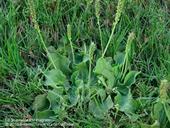- Author: Karey Windbiel-Rojas

Looking for ways to manage weeds in your lawn or landscape? Join us on July 21, 2022 at noon for UC IPM's free monthly webinar to learn about how to control weeds using mostly nonchemical methods. We will discuss why weed identification is important, ways to prevent weed growth, and combining various methods for managing weed problems.
The webinar will be presented by Karey Windbiel-Rojas, Area Urban IPM Advisor and Associate Director for Urban & Community IPM with the UC Statewide IPM Program. Register today to serve your spot!
As always, the webinar will be recorded and...
- Author: Tunyalee A. Martin
- Author: Cheryl A. Wilen
- Author: Thomas Getts
- Author: Jutta Burger, Cal-IPC
- View More...

California has abundant wildlands — forests, rangeland, open areas, wildlife refuges and national, state, and local parks — that need protection from invasive plants. Invasive plants affect all Californians by increasing wildfire potential; reducing water resources; accelerating erosion and flooding; threatening wildlife; degrading range, crop and timberland; and diminishing outdoor recreation opportunities. According to the California Invasive Plant Council (Cal-IPC), more than 200 identified plant species harm California's wildlands.
Cal-IPC and the University of California...
![Mallow (cheeseweed). [Credit: Jack Kelly Clark]](https://ucanr.edu/blogs/UCIPMurbanpests/blogfiles/55647small.jpg)
Controlling weeds can be challenging to landscape professionals or home gardeners since landscapes often include a mix of turfgrass, annual plants, herbaceous perennials, shrubs, and trees.
The newly revised publication Pest Notes: Weed Management in Landscapes by Area IPM Advisor Cheryl Wilen, presents an integrated approach to weed management to help ensure weed control efforts are effective, environmentally-sound and economical. This science-based publication includes information on methods such as pre-planting considerations, the importance of weed identification, nonchemical practices such as using mulches and barriers, weed management...
![Adult hoplia beetle and feeding damage. [J.K.Clark]](https://ucanr.edu/blogs/UCIPMurbanpests/blogfiles/43235small.jpg)
If you grow roses, you might be noticing damage on the flowers caused by hoplia beetles (Hoplia callipyge). Hoplia beetles, which are common between March and May, especially in the Central Valley, feed on the blossoms of light-colored roses and other flowers in your landscape.
Hoplia beetle adults are small, reddish-brown scarab beetles that are often found resting inside a blossom. If you hold one in your hand, you'll notice that most of the body is a beautiful, iridescent silvery green color in the sunlight.
These beetles may also occasionally be found feeding on other plants with light-colored petals.
Some people believe they have the rose chafer or Japanese beetle in their landscape, however...


